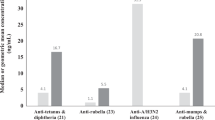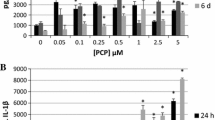Abstract
As a ubiquitous and highly persistent environmental contaminant, the clear mechanisms to explain any perfluorooctanesulfonate (PFOS)-induced immunotoxicity are still unknown. This study here sought to examine the ability of PFOS to potentially perturb T-helper (TH)-1 and TH-2 cell cytokine secreting activities, as well as to cause shifts in antibody isotype levels, and possible mechanisms involved in PFOS-induced immunotoxicity. Adult male C57BL/6 mice were exposed to PFOS daily via gavage for 60 days [0, 0.5, 1, 5, 25, or 50 mg/kg total administered dose (TAD)]. One day after the final exposure, the ex vivo production of the TH1-type cytokines (IL-2 and IFN-γ), TH2-type (IL-4), and IL-10 cytokines by isolated splenocytes, serum levels of immunoglobulin (Ig) were assessed via ELISA or ELISPOT. The results showed that IL-4 secretion was increased at exposure ≥5 mg PFOS/kg TAD in a dose-dependent manner. PFOS exposure increased IL-10 but decreased IL-2 and IFN-γ formation markedly at 50 mg PFOS/kg TAD. Serum levels of sheep red blood cells (SRBC)-specific IgM synthesis decreased significantly with PFOS exposure in a dose-related manner; serum SRBC-specific IgG, IgG1, and IgE levels increased with 50 mg PFOS/kg TAD regimens. These results indicated that, after a long-term exposure to PFOS, a host’s immune state is likely to be characterized by a shift toward a more TH2-like state that, in turn, may lead to enhancement of their humoral response and suppression of their cellular response at levels of upper range for occupationally exposed workers or approximately 150-fold for general human population.


Similar content being viewed by others
References
Alexander BH, Olsen GW, Burris JM, Mandel JH, Mandel JS (2003) Mortality of employees of a perfluorooctanesulphonyl fluoride manufacturing facility. Occup Environ Med 60:722–729
Ankley GT, Kuehl DW, Kahl MD, Jensen KM, Linnum A, Leino RL, Villeneuvet DA (2005) Reproductive and developmental toxicity and bioconcentration of perfluorooctanesulfonate in a partial life-cycle test with the fathead minnow (Pimephales promelas). Environ Toxicol Chem 24:2316–2324
Berghella AM, Contasta I, Pellegrini P, Del Beato T, Adorno D (2006) Are immunological mechanisms involved in colon cancer and are they possible markers for biotherapy improvement? Cancer Biother. Radiopharm 21:468–487
Bermejo-Martin JF, Ortiz de Lejarazu R, Pumarola T, Rello J, Almansa R, Ramírez P (2009) Th1 and Th17 hypercytokinemia as early host response signature in severe pandemic influenza. Crit Care 13:R201
Bouman A, Heineman MJ, Faas MM (2005) Sex hormones and the immune response in humans. Hum Reprod Update 11:411–423
Butenhoff JL, Olsen GW, Pfahles-Hutchens A (2006) The applicability of biomonitoring data for perfluorooctanesulfonate to the environmental public health continuum. Environ Health Perspect 114:1776–1782
DeWitt JC, Copeland CB, Strynar MJ, Luebke RW (2008) Perfluorooctanoic acid-Induced immunomodulation in adult C57BL/6 J or C57BL/6 N female mice. Environ Health Perspect 116:644–650
DeWitt JC, Copeland CB, Strynar MJ, Luebke RW (2009) Suppression of Humoral Immunity by Perfluorooctanoic Acid is Independent of Elevated Serum Corticosterone Concentration in Mice. Toxicol Sci 109:106–112
Dong GH, Zhang YH, Zheng L, Liu W, Jin YH, He QC (2009) Chronic effects of perfluorooctanesulfonate (PFOS) exposure on immunotoxicity in adult male C57BL/6 mice. Arch Toxicol 83:805–815
Fei C, McLaughlin JK, Lipworth L, Olsen J (2010) Prenatal exposure to PFOA and PFOS and risk of hospitalization for infectious diseases in early childhood. Environ Res 110:773–777
Fietta P, Delsante G (2009) The effector T helper cell triade. Riv Biol 102:61–74
Francis J, MohanKumar SM, MohanKumar PS (2000) Correlations of norepinephrine release in the paraventricular nucleus with plasma corticosterone and leptin after systemic lipopolysaccharide: blockade by soluble IL-1 receptor. Brain Res 867:180–187
Galon J, Costes A, Sanchez-Cabo F, Kirilovsky A, Mlecnik B, Lagorce-Pages C, Tosolini M, Camus M, Berger A, Wind P, Zinzindohoue F, Bruneval P, Cugnenc PH, Trajanoski Z, Fridman WH, Pages F (2006) Type, density, and location of immune cells within human colorectal tumors predict clinical outcome. Science 313:1960–1964
Giesy JP, Kannan K (2001) Global distribution of perfluorooctane sulfonate in wildlife. Environ Sci Technol 35:1339–1342
Gilliland FD, Mandel JS (1993) Mortality among employees of a perfluorooctanoic acid production plant. Occup Med 35:950–954
Guruge KS, Hikono H, Shimada N, Murakami K, Hasegawa J, Yeung LW, Yamanaka N, Yamashita N (2009) Effect of perfluorooctane sulfonate (PFOS) on influenza A virus-induced mortality in female B6C3F1 mice. J Toxicol Sci 34:687–691
Hansen KJ, Clemen LA, Ellefson ME, Johnson HO (2001) Compound-specific, quantitative characterization of organic fluorochemicals in biological matrices. Environ Sci Technol 35:766–770
Hasbold J, Hong JS, Kehry MR, Hodgkin PD (1999) Integrating signals from IFNγ and IL-4 by B-cells: Positive and negative effects on CD40 ligand-induced proliferation, survival, and division-linked isotype switching to IgG1, IgE, and IgG2a. J Immunol 163:4175–4181
Hoffman K, Webster TF, Weisskopf MG, Weinberg J, Vieira VM (2010) Exposure to polyfluoroalkyl chemicals and attention deficit hyperactivity disorder in U.S. children aged 12–15 years. Environ Health Perspect. doi:10.1289/ehp.1001898
Houde M, Bujas TA, Small J, Wells RS, Fair PA, Bossart GD, Solomon KR, Muir DC (2006) Biomagnification of perfluoroalkyl compounds in the bottlenose dolphin (Tursiops truncatus) food web. Environ Sci Technol 40:4138–4144
Jin Y, Saito N, Harada KH, Inoue K, Koizumi A (2007) Historical trends in human serum levels of perfluorooctanoate and perfluorooctane sulfonate in Shenyang. China Tohoku J Exp Med 212:63–70
Joensen UN, Bossi R, Leffers H, Jensen AA, Skakkebaek NE, Jørgensen N (2009) Do perfluoroalkyl compounds impair human semen quality? Environ Health Perspect 117:923–927
Lau C, Anitole K, Hodes C, Lai D, Pfahles-Hutchens A, Seed J (2007) Perfluoroalkyl acids: a review of monitoring and toxicological findings. Toxicol Sci 99:366–394
Lefebvre DE, Curran I, Armstrong C, Coady L, Parenteau M, Liston V, Barker M, Aziz S, Rutherford K, Bellon-Gagnon P, Shenton J, Mehta R, Bondy G (2008) Immunomodulatory eVects of dietary potassium eprXuorooctane sulfonate (PFOS) exposure in adult Sprague-Dawley Rats. J Toxicol Environ Health A 71:1516–1525
OECD (Organisation for Economic Co-operation and Development) (2002) Hazard assessment of perfluorooctane sulfonate (PFOS) and its salts. Available: http://www.oecd.org/dataoecd/23/18/2382880.pdf
Olsen GW, Burris JM, Ehresman DJ, Froehlich JW, Seacat AM, Butenhoff JL, Zobel LR (2007) Half-life of serum elimination of perfluorooctanesulfonate, perfluorohexane-sulfonate, and perfluorooctanoate in retired fluorochemical production workers. Environ Health Perspect 115:1298–1305
Peden-Adams MM, Keller JM, EuDaly JG (2008) Suppression of humoral immunity in mice following exposure to perfluorooctane sulfonate. Toxicol Sci 104:144–154
Pene J, Rousset F, Briere F, Chretien I, Bonnefoy JY, Spits H, Yokota T, Arai N, Arai K, Banchereau J (1988) IgE production by normal human lymphocytes is induced by IL-4 and suppressed by IFNγ and prostaglandin E2. Proc Natl Acad Sci USA 85:6880–6884
Qazi MR, Bogdanska J, Butenhoff JL, Nelson BD, DePierre JW, Abedi-Valugerdi M (2009) High-dose, short-term exposure of mice to perfluorooctanesulfonate (PFOS) or perfluorooctanoate (PFOA) affects the number of circulating neutrophils differently, but enhances the inflammatory responses of macrophages to lipopolysaccharide (LPS) in a similar fashion. Toxicology 262:207–214
Reichlin S (2004) Neuroendocrinology of acute immunity. J Endocrinol Invest 27:48–61
Rylander C, Sandanger TM, Frøyland L, Lund E (2010) Dietary patterns and plasma concentrations of perfluorinated compounds in 315 Norwegian women: the NOWAC postgenome study. Environ Sci Technol 44:5225–5232
Shakhar G, Blumenfeld B (2003) Glucocorticoid involvement in suppression of NK activity following surgery in rats. J Neuroimmunol 138:83–91
Spiegelberg HL (1990) The role of interleukin-4 in IgE and IgG subclass formation. Springer Semin Immunopathol 12:365–383
Spiegelberg HL, Falkoff RJ, O’Connor RD, Beck L (1991) Interleukin-2 inhibits IL-4-induced human IgE and IgG4 secretion in vivo. Clin Exp Immunol 84:400–405
Stockholm Convention on Persistent organic Pollutants (2009) Governments unite to step-up reduction on global DDT reliance and add nine new chemicals under international treaty. Geneva: Stockholm Convention Secretariat. May 8. Available: http://chm.pops.int/Convention/Pressrelease/COP4Geneva8May2009/tabid/542/language/en-US/Default.aspx
Titus RG, Chiller JM (1981) A simple and effective method to assess murine delayed-type hypersensitivity to proteins. J Immunol Methods 45:65–78
U.S. EPA (U.S. Environmental Protection Agency), SAB Review of EPA’s Draft (2006) Risk assessment of potential human health effects associated with PFOA and its salts. EPA-SAB-06-006. May 30. Available: http://yosemite.epa.gov/sab/sabpeople.nsf/WebCommittees/BOARD
Wang F, Liu W, Jin Y, Dai J, Yu W, Liu X, Liu L (2010) Transcriptional effects of prenatal and neonatal exposure to PFOS in developing rat brain. Environ Sci Technol 44:1847–1853
Washino N, Saijo Y, Sasaki S, Kato S, Ban S, Konishi K, Ito R, Nakata A, Iwasaki Y, Saito K, Nakazawa H, Kishi R (2009) Correlations between prenatal exposure to perfluorinated chemicals and reduced fetal growth. Environ Health Perspect 117:660–667
Yu WG, Liu W, Jin YH, Liu XH, Wang FQ, Liu L, Nakayama SF (2009) Prenatal and postnatal impact of perfluorooctane sulfonate (PFOS) on rat development: a cross-foster study on chemical burden and thyroid hormone system. Environ Sci Technol 43:8416–8422
Acknowledgments
This research was supported by grants from the National Natural Science Foundation of China (20707041), the Liaoning Province Science and Technology Foundation (2009225010-6), and the Education Department Foundation (L2010706).
Conflict of interest
The authors report no conflicts of interest. The authors are alone responsible for the content and writing of the paper.
Author information
Authors and Affiliations
Corresponding authors
Rights and permissions
About this article
Cite this article
Dong, GH., Liu, MM., Wang, D. et al. Sub-chronic effect of perfluorooctanesulfonate (PFOS) on the balance of type 1 and type 2 cytokine in adult C57BL6 mice. Arch Toxicol 85, 1235–1244 (2011). https://doi.org/10.1007/s00204-011-0661-x
Received:
Accepted:
Published:
Issue Date:
DOI: https://doi.org/10.1007/s00204-011-0661-x




